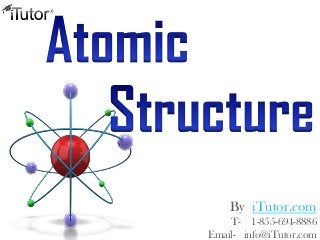2. What is Atom?
The smallest unit of matter that retains the identity of the
substance.
Atoms are the basic building blocks of matter that make up
everyday objects. A desk, the air, even you are made up of
atoms.
There are 90 naturally occurring kinds of atoms. Scientists in
labs have been able to make about 25 more.
Atoms are made out of three basic particles:
Protons, Neutrons and Electrons.
© iTutor. 2000-2013. All Rights Reserved
Atoms are composed of 2 regions:
Nucleus: the center of the atom that contains the mass of the
atom.
Electron Shell: region that surrounds the nucleus that contains
most of the space in the atom.
Atomic Structure
3. What is Nucleus ?
The nucleus of an atom contains protons and neutrons. The
nucleus carries a positive electrical charge. Electrons move
around outside the nucleus.
Almost all of the mass of an atom is in its nucleus; almost all
of the volume of an atom is occupied by electrons.
Electron
Proton
Neutron
Carbon nucleus
© iTutor. 2000-2013. All Rights Reserved
Electrons are basically the
connectors in the process of
bonding. The bond is determined
by the amount of valence
electrons the element has.
Protons are positively charged, while Neutrons are neutral
(hence the name), and attract the negatively charged electrons
to the nucleus, where they both reside.
Neutrons are also those who prevents the protons to get out of
the nucleus.
4. © iTutor. 2000-2013. All Rights Reserved
Quantum Theory
The quantum mechanical model is based on quantum theory,
which says matter also has properties associated with waves.
According to quantum theory, it’s impossible to know the
exact position and momentum of an electron at the same time.
The quantum mechanical model of the atom uses complex
shapes of orbital's (sometimes called electron clouds or
electron shell), volumes of space in which there is likely to be
an electron.
5. The Bohr Model has an atom consisting of a small, positively-
charged nucleus orbited by negatively-charged electrons.
Electrons orbit the nucleus in orbits that have a set size and
energy.
The energy of the orbit is related to its size. The lowest energy
is found in the smallest orbit.
Radiation is absorbed or emitted when an electron moves
from one orbit to another.
Bohr’s Model
© iTutor. 2000-2013. All Rights Reserved
The Rutherford–Bohr model of
the hydrogen atom (Z = 1) or a hydrogen-
like ion (Z > 1), where the negatively
charged electron confined to an atomic
shell encircles a small, positively
charged atomic nucleus and where an
electron jump between orbits is
accompanied by an emitted or absorbed
amount of electromagnetic energy (hν).
6. © iTutor. 2000-2013. All Rights Reserved
The orbits in which the electron may travel are shown as grey circles;
their radius increases as n2, where n is the principal quantum number.
The3 → 2 transition depicted here produces the first line of the Balmer
series, and for hydrogen (Z = 1) it results in a photon
of wavelength656 nm (red light).
Limitation of Bohr’s Model
It is in violation of the Heisenberg Uncertainty Principle. The
Bohr Model considers electrons to have both a known radius
and orbit, which is impossible according to Heisenberg.
The Bohr Model is very limited in terms of size. Poor spectral
predictions are obtained when larger atoms are in question.
It cannot predict the relative intensities of spectral lines.
It does not explain the Zeeman Effect, when the spectral line
is split into several components in the presence of a magnetic
field.
The Bohr Model does not account for the fact that accelerating
electrons do not emit electromagnetic radiation.
7. Calculate the number of Protons, Neutrons and Electron
The atomic number is the number of
protons in an atom of an element. In
our example, krypton's atomic
number is 36. This tells us that an
atom of krypton has 36 protons in
its nucleus.
Atomic
Number
Atomic
weight
© iTutor. 2000-2013. All Rights Reserved
The atomic weight is basically a measurement of the total
number of particles in an atom's nucleus.
To find the mass number, all you need to do is round the
atomic weight to the nearest whole number. In our
example, krypton's mass number is 84 since its atomic
weight, 83.80, rounds up to 84.
Mass Number = (Number of Protons) + (Number of Neutrons)
84 = 36 + (Number of Neutrons)
Number of Neutrons = 84-36
Number of Neutrons = 48
8. Atoms must have equal numbers of protons and electrons.
In our example, an atom of krypton must contain 36
electrons since it contains 36 protons.
In Summary
Number of Protons = Atomic Number
Number of Electrons = Number of Protons = Atomic Number
Number of Neutrons = Mass Number - Atomic Number
Call us for more
Information
www.iTutor.com
Visit
1-855-694-8886
